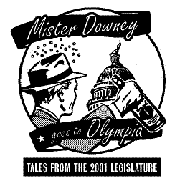SO YOU COME HOME beat after a long day at work and the dog has thrown up on the hall carpet and, boy, a gin and tonic would taste good right now. But there is exactly one quarter inch of gin in the bottle and the nearest liquor store closes in 20 minutes. Damn this state liquor monopoly!
Most Washingtonians with a taste for strong drink must have said something like this on occasion, and we have rich and powerful friends who feel even more strongly on the subject: the multinational booze conglomerates, the brokers and distributors who dominate the market, the retail chains that would profit mightily if the state would just get the hell out of the liquor business. With so many arrayed against it, how has an anachronism like the Washington State Liquor Control Board managed to hang onto its monopoly ever since Prohibition ended in 1933?
That question got an uncharacteristically bold answer this month when something called the “Governor’s Retail Liquor Sales Task Force” presented its findings—bold because the findings aren’t what the Governor, a devotee of privatizing liquor sales, wanted them to find. Its report runs to hundreds of pages but can be boiled down to just eight words: The present system ain’t broke; don’t fix it.
What we tend to forget when we bitch about the inconveniences of the present system for the consumer is that the system is designed to be inconvenient. The idea is to discourage consumption, particularly by minors and alcohol abusers, while recognizing that people who are determined to drink will do so, and to steer at least a modicum of what they spend on their drug of choice toward cleaning up and countering the damage some do when they use it.
The task force found that states with private or quasi-private (franchised) liquor sales systems rack up greater consumption per capita, are less successful at keeping liquor out of the hands of underage and problem drinkers, and deliver far less revenue to the state. While recognizing room for improvement in efficiency, user-friendliness, and community sensitivity, the study came to the Churchillian conclusion that the Liquor Board’s system is the worst around, except for all the others.
There’s another, straightforwardly political argument supporting the present system: There’s no groundswell of public opposition to it. Nevertheless, no legislative session passes without bills to “liberalize” state laws on alcohol sales. People who firmly believe that the state does not belong in the retail booze business introduce some of these bills—people like Mukilteo Democrat Paull Shinn, who wants to see alcohol sales on Washington state ferries ended. But such people are few and powerless compared with those who think otherwise.
Other legislators focus on the state’s distortion of the “free market.” Take, for ex- ample, House Bill 1806, co-sponsored by Selah Republican Jim Clements and Spokane Democrat Alex Wood, designed to “diminish the [liquor] board’s unfair competitive advantage” over private retailers for the public’s wine and beer buck.
Now it’s true that the state is a big buyer of beer and wine and, like all big buyers, enjoys some price breaks from suppliers. But it’s also true, as the task force notes, that virtually all the beer and over 90 percent of the wine sold in Washington is sold by private retailers, so the “unfair advantage” enjoyed by the state over, say, a chain on the scale of Safeway is more apparent than real. Never mind, says the bill, state stores must be forced to mark up wine and beer an average of at least 25 percent over cost in order to ensure a level playing field for private retailers.
Doesn’t this smack of price fixing, even a kind of legalized public-private collusion on how much customers have to pay for their Bud Light? Some legislators think so, and as of press time, the Clements-Wood bill had no additional sponsors and looked like it would expire without even a committee hearing.
It may have already served its purpose. Even co-sponsor Wood grants that legislation may not be the best way to deal with such a delicate matter. “I think it is probably better if the industry sits down with the [Liquor Board] commissioners and they work it out between them.”
Not to worry, such a meeting has taken place: On January 30, Safeway lobbyist Janice “the Tiger” Gee put the retail industry case before the Liquor Board at its weekly meeting with staff. Don’t be surprised if the Liquor Board sees the light and raises its markups in the name of fairness.
After all, the fairness argument has worked before. In 1999, at the retailers’ urging, the Liquor Board surveyed its prices compared to the open market and concluded the two weren’t significantly different. Still, to keep the private sector happy, they jacked up their wine prices by $1.80 a case.
“Fairness” can also be profitable. Former Liquor Commissioner Robert Hanna recalls how back in the late ’80s, retailers persuaded him and his colleagues to jack up beer and wine prices across the board to “level the playing field.” He also recalls that as soon as the new prices were posted, private retailers jacked up theirs by an identical amount. A level playing field? Tilt!








